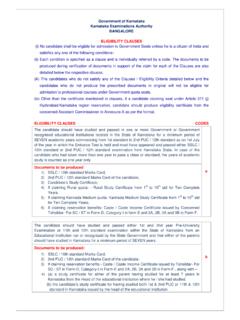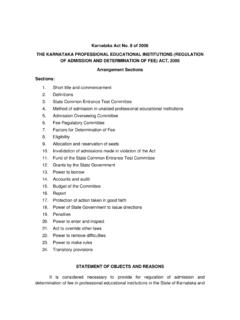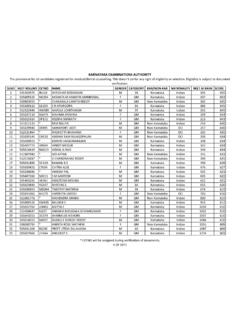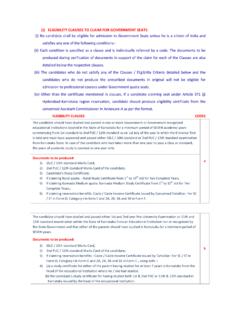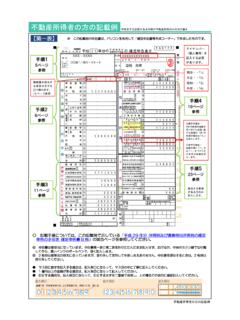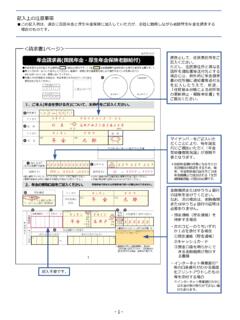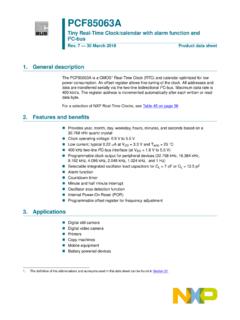Transcription of CHAPTER. 15. PLANT GROWTH AND DEVELOPMENT - Kar
1 CHAPTER. 15. PLANT GROWTH AND DEVELOPMENT Increase in the size of living organisms is commonly called GROWTH . Many physiological processes play an important role during GROWTH of plants and animals. In plants seed germinates and develops into a seedling and later it assumes the shape of an adult PLANT . Plants show indefinite and diffuse GROWTH while animals show fixed and uniform GROWTH . GROWTH may be defined as an irreversible permanent increase in size, volume or mass of a cell or organ or whole organism accompanied by an increase in dry weight. Types of GROWTH Primary and secondary GROWTH .
2 The mitotic division of meristematic cells present at the root and shoot apex increases the length of the PLANT body. This is called the primary GROWTH . The secondary meristem increases the diameter of the PLANT body and it is called the secondary GROWTH . Unlimited GROWTH - The root and the shoot system of plants grow continuously from germination stage to the death or throughout the life span of the PLANT . It is called Unlimited or indeterminate type of GROWTH . Limited GROWTH - The leaves, fruits and flowers stop growing after attaining certain size.
3 This is called limited or determinate type of GROWTH . Fig. Stages of GROWTH -seed germination to a complete PLANT Vegetative GROWTH - The earlier GROWTH of PLANT producing leaves, stem and branches without flowers is called vegetative GROWTH / Phase. Reproductive GROWTH - After the vegetative GROWTH , plants produce flowers which is the reproductive part of the PLANT . This is called reproductive GROWTH /phase. GROWTH curve It is an S shaped curve obtained when we plot GROWTH against time (Fig. ). It is also called sigmoid curve. This curve mainly shows four phases of GROWTH - slow GROWTH (Lag phase), 2.
4 The rapid period of GROWTH (log phase/grand period of GROWTH /exponential phase) where maximum GROWTH is seen in a short period and 3. The diminishing phase where GROWTH will be slow and 4. Stationary / steady phase where finally GROWTH stops. Fig. GROWTH CURVE- GROWTH PLOTTED AGAINST TIME , dedifferentiation and redifferentiation of cells The three phases of cell GROWTH are cell division, cell enlargement and cell differentiation. The first two stages increase the size of the PLANT cell while the 3rd stage brings maturity to the cells.
5 Differentiation, is a process during which cells undergoes structural changes in the cell wall and protoplasm (Fig. ). A differentiated cell cannot divide. Phases of Cell GROWTH -Cell division, cell elongation and cell differentiation phases An undividable differentiated cell sometimes regains the power of division. This process is called dedifferentiation. Dedifferentiation is a common process in plants during secondary GROWTH and in wound healing mechanisms. A dedifferentiated cell can divide and produce new cells. Thus produced new cells again loose the power of division and become a part of permanent tissue.
6 This process is called redifferentiation . Tumour cells form good example for redifferentiated cells. DEVELOPMENT is defined as sum total of GROWTH and differentiation. DEVELOPMENT is governed by both environmental and internal factors. One of the internal factors that regulate GROWTH and DEVELOPMENT is PLANT hormones . PLANT hormones/ phytohormones/ Growthregulators- PLANT hormones are chemically diverse substances produced in minute quantity and they involve in most of the PLANT cell activities. They regulate the GROWTH process both by promoting and inhibiting GROWTH .
7 They are produced in certain parts of the PLANT and transported to other tissues where their action is shown. Based on their promotory and inhibitory activity they have been classified into GROWTH promoters and GROWTH inhibitors. Name and functions of GROWTH regulators GROWTH promoters Some Functions of GROWTH promoters GROWTH inhibitors Functions of GROWTH inhibitors 1 Auxins, , 1. Cell division. enlargement movement and flowering germination formation 1. Ethylene 2 Dormin or abscissic acid 1. Induces senescence. dormancy of seeds Photoperiodism It has been discovered that duration of light also plays a major role in inducing flowering in plants.
8 This flowering response in plants to the relative length of light and dark periods within a 24 hour cycle is called Photoperiodism . Every PLANT has a specific critical period of light duration needed for flowering. In order to flower they must be exposed to either more or less light hour than that of critical period. Based on flowering response to light duration, plants have been classified into Long day plants, short day plants and day neutral plants. Long day plants (LDP)- They are plants which produce flower only when they are exposed to light duration more than the critical period.
9 They produce flower in summer. and Rye plants. Short day plants (SDP)- They are plants which produce flower only when they are exposed to light duration shorter than the critical period. They produce flower in spring or winter. Chrysanthemum, Tobacco and Coffee. Day neutral plants- They produce flowers throughout the year irrespective of length of light hours to which they are exposed. Tomato Vernalisation Some biennials like carrot, cabbage and sugar beet need a cold/low temperature treatment before they flower. This is called vernalisaion.
10 In other words, Vernalisation is promotion of flowering by low temperature treatment. Spraying gibberellins is a substitute to cold treatment and biennials can be made to flower in one year without the cold treatment. SUMMARY GROWTH in an irreversible increase in mass, volume or weight of an organism accompanied by increase in dry weight. Plants GROWTH shows vegetative and reproductive phases. Some parts of the PLANT like fruits and leaves show limited GROWTH , where as stem and root show unlimited GROWTH . The rate of GROWTH can be measured, by plotting GROWTH against time.
